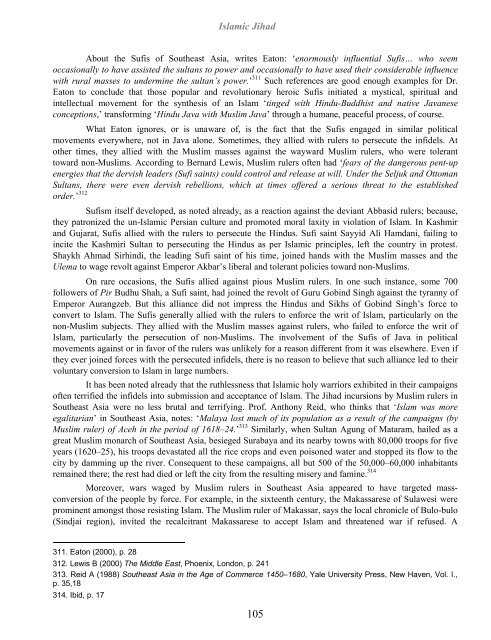islamic-jihad-legacy-of-forced-conversion-imperialism-slavery
islamic-jihad-legacy-of-forced-conversion-imperialism-slavery
islamic-jihad-legacy-of-forced-conversion-imperialism-slavery
- No tags were found...
Create successful ePaper yourself
Turn your PDF publications into a flip-book with our unique Google optimized e-Paper software.
Islamic JihadAbout the Sufis <strong>of</strong> Southeast Asia, writes Eaton: ‘enormously influential Sufis… who seemoccasionally to have assisted the sultans to power and occasionally to have used their considerable influencewith rural masses to undermine the sultan’s power.’ 311 Such references are good enough examples for Dr.Eaton to conclude that those popular and revolutionary heroic Sufis initiated a mystical, spiritual andintellectual movement for the synthesis <strong>of</strong> an Islam ‘tinged with Hindu-Buddhist and native Javaneseconceptions,’ transforming ‘Hindu Java with Muslim Java’ through a humane, peaceful process, <strong>of</strong> course.What Eaton ignores, or is unaware <strong>of</strong>, is the fact that the Sufis engaged in similar politicalmovements everywhere, not in Java alone. Sometimes, they allied with rulers to persecute the infidels. Atother times, they allied with the Muslim masses against the wayward Muslim rulers, who were toleranttoward non-Muslims. According to Bernard Lewis, Muslim rulers <strong>of</strong>ten had ‘fears <strong>of</strong> the dangerous pent-upenergies that the dervish leaders (Sufi saints) could control and release at will. Under the Seljuk and OttomanSultans, there were even dervish rebellions, which at times <strong>of</strong>fered a serious threat to the establishedorder.’ 312 Sufism itself developed, as noted already, as a reaction against the deviant Abbasid rulers; because,they patronized the un-Islamic Persian culture and promoted moral laxity in violation <strong>of</strong> Islam. In Kashmirand Gujarat, Sufis allied with the rulers to persecute the Hindus. Sufi saint Sayyid Ali Hamdani, failing toincite the Kashmiri Sultan to persecuting the Hindus as per Islamic principles, left the country in protest.Shaykh Ahmad Sirhindi, the leading Sufi saint <strong>of</strong> his time, joined hands with the Muslim masses and theUlema to wage revolt against Emperor Akbar’s liberal and tolerant policies toward non-Muslims.On rare occasions, the Sufis allied against pious Muslim rulers. In one such instance, some 700followers <strong>of</strong> Pir Budhu Shah, a Sufi saint, had joined the revolt <strong>of</strong> Guru Gobind Singh against the tyranny <strong>of</strong>Emperor Aurangzeb. But this alliance did not impress the Hindus and Sikhs <strong>of</strong> Gobind Singh’s force toconvert to Islam. The Sufis generally allied with the rulers to enforce the writ <strong>of</strong> Islam, particularly on thenon-Muslim subjects. They allied with the Muslim masses against rulers, who failed to enforce the writ <strong>of</strong>Islam, particularly the persecution <strong>of</strong> non-Muslims. The involvement <strong>of</strong> the Sufis <strong>of</strong> Java in politicalmovements against or in favor <strong>of</strong> the rulers was unlikely for a reason different from it was elsewhere. Even ifthey ever joined forces with the persecuted infidels, there is no reason to believe that such alliance led to theirvoluntary <strong>conversion</strong> to Islam in large numbers.It has been noted already that the ruthlessness that Islamic holy warriors exhibited in their campaigns<strong>of</strong>ten terrified the infidels into submission and acceptance <strong>of</strong> Islam. The Jihad incursions by Muslim rulers inSoutheast Asia were no less brutal and terrifying. Pr<strong>of</strong>. Anthony Reid, who thinks that ‘Islam was moreegalitarian’ in Southeast Asia, notes: ‘Malaya lost much <strong>of</strong> its population as a result <strong>of</strong> the campaigns (byMuslim ruler) <strong>of</strong> Aceh in the period <strong>of</strong> 1618–24.’ 313 Similarly, when Sultan Agung <strong>of</strong> Mataram, hailed as agreat Muslim monarch <strong>of</strong> Southeast Asia, besieged Surabaya and its nearby towns with 80,000 troops for fiveyears (1620–25), his troops devastated all the rice crops and even poisoned water and stopped its flow to thecity by damming up the river. Consequent to these campaigns, all but 500 <strong>of</strong> the 50,000–60,000 inhabitantsremained there; the rest had died or left the city from the resulting misery and famine. 314Moreover, wars waged by Muslim rulers in Southeast Asia appeared to have targeted mass<strong>conversion</strong><strong>of</strong> the people by force. For example, in the sixteenth century, the Makassarese <strong>of</strong> Sulawesi wereprominent amongst those resisting Islam. The Muslim ruler <strong>of</strong> Makassar, says the local chronicle <strong>of</strong> Bulo-bulo(Sindjai region), invited the recalcitrant Makassarese to accept Islam and threatened war if refused. A311. Eaton (2000), p. 28312. Lewis B (2000) The Middle East, Phoenix, London, p. 241313. Reid A (1988) Southeast Asia in the Age <strong>of</strong> Commerce 1450–1680, Yale University Press, New Haven, Vol. I.,p. 35,18314. Ibid, p. 17105


